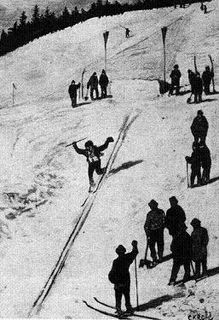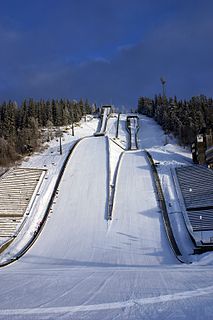
The 1952 Winter Olympics, officially known as the VI Olympic Winter Games and commonly known as Oslo 1952, was a winter multi-sport event held from 14 to 25 February 1952 in Oslo, the capital of Norway.

Holmenkollbakken is a large ski jumping hill located at Holmenkollen in Oslo, Norway. It has a hill size of HS134, a construction point of K-120, and a capacity for 70,000 spectators. Holmenkollen has hosted the Holmenkollen Ski Festival since 1892, which since 1980 have been part of the FIS Ski Jumping World Cup and 1983 the FIS Nordic Combined World Cup. It has also hosted the 1952 Winter Olympics and the FIS Nordic World Ski Championships in 1930, 1966, 1982 and 2011.

Husebyrennet was a ski jumping competition which was held in Ullern, Oslo, Norway. These yearly competitions, held from 1879 to 1891, were a precursor to the Holmenkollen event. Starting in January 1892, this competition relocated to the Holmenkollbakken in Holmenkollen.

Lysgårdsbakken, officially known as Lysgårdsbakkene Ski Jumping Arena, is a ski jumping hill in Lillehammer, Norway. It consists of a large hill, with a K-point of 123 and a hill size of 138, and a small hill with a K-point of 90 and a hill size of 100. It opened in 1993 for the 1994 Winter Olympics, where it hosted the ski jumping and Nordic combined events, as well as the opening and closing ceremonies. After the Olympics, ownership was transferred to the municipal Lillehammer Olympiapark and it has since been used for several FIS Ski Jumping World Cup and FIS Nordic Combined World Cup tournaments, including hosting the Nordic Tournament. It has a capacity for 35,000 spectators and is one of three national ski jumping hills in Norway. In 2007, the large hill was rebuilt to a larger profile, and received a new plastic lining. The venue sees 80,000 annual jumps in the winter and 20,000 in the summer season.

Karl Frithjof Hovelsen was a Norwegian Nordic skier. Howelsen Hill Ski Area in Steamboat Springs, Colorado was named in his honor.

The FIS Nordic World Ski Championships 2011 took place from 23 February to 6 March 2011 in Oslo, Norway, at the Holmenkollen National Arena. It was the fifth time these championships had been hosted in Holmenkollen, having been done previously in 1930, the 1952 Winter Olympics, 1966, and 1982. On 25 May 2006, the 45th FIS Congress in Vilamoura, Portugal, selected the Holmenkollen area over both Val di Fiemme, Italy, and Zakopane, Poland, with a vote of 12 to 4 to 0. These games coincided with the Holmenkollen Ski Festival as they have previously in 1930, 1952, 1966, and 1982.
The Holmenkollen Ski Festival is a traditional annual Nordic skiing event in Holmenkollen, Oslo, Norway. The full official name of the event is Holmenkollen FIS World Cup Nordic.

Holmenkollen Ski Museum is located at the base of the Holmenkollen ski jump in Oslo, Norway.

The XXV Winter Universiade, took place in Erzurum, Turkey between 27 January to 6 February. Erzurum is the city at the highest altitude in Turkey, at 1,850 m (6,070 ft), and has over 320 cultural landmarks. Located in Eastern Anatolia Region, it is a city on the traditional silk road and has been governed by many cultures over the centuries. The Erzurum Ice Hockey Arena, located on the Cemal Gürsel Sports Campus, was newly built with an ice rink of 60m x 30m and 3,000 seats for spectators.

The 2016 Winter Youth Olympics, officially known as the II Winter Youth Olympic Games, took place in and around Lillehammer, Norway, between 12 February and 21 February 2016. They were the fourth Youth Olympic Games and the second winter edition. Lillehammer was awarded the games on 7 December 2011 as the only candidate. The games reused venues from the 1994 Winter Olympics; this made Lillehammer the first city to host both regular and Youth Olympics. In addition to Lillehammer, sports were contested in Hamar, Gjøvik and Øyer.

Birkebeineren Ski Stadium is a cross-country skiing and biathlon venue located in Lillehammer, Norway. Situated 3 kilometers (2 mi) from the town center and at 485 meters (1,591 ft) above mean sea level, it has two stadium areas, one for cross-country and one for biathlon. The former has a capacity for 31,000 spectators, and the latter for 13,500. The venue was built for the 1994 Winter Olympics, costing 83.6 million Norwegian krone (NOK). It was subsequently used by the 1994 Winter Paralympics for Paralympic Nordic skiing and Paralympic biathlon. After the games, ownership was transferred to the municipal Lillehammer Olympiapark. The venue has since been used for one Biathlon World Cup, three FIS Cross-Country World Cup and nine FIS Nordic Combined World Cup tournaments, the latter with the ski jumping competition taking place at the nearby Lysgårdsbakkene Ski Jumping Arena. Birkebeineren hosted the 2016 Winter Youth Olympics.

Lillehammer Olympiapark AS, trading as Olympiaparken, is a company established following the 1994 Winter Olympics to operate the Olympic venues in Lillehammer, Norway. Owned by Lillehammer Municipality, it operates five sports venues: Birkebeineren Ski Stadium, Håkons Hall, Lillehammer Olympic Bobsleigh and Luge Track, Kanthaugen Freestyle Arena and the ski jumping hill of Lysgårdsbakken. In addition to serving sports events, the company provides tourist and group activities at the venues as well as catering to larger events.

The 1994 Winter Olympics were held in and around Lillehammer, Norway, from 12 to 27 February 1994. Ten competition and fourteen non-competition venues were used, most of which were subsequently used for the 1994 Winter Paralympics. The Games were spread out over ten venues in five municipalities in two counties, Oppland and Hedmark. Lillehammer, with approximately 25,000 inhabitants, and Hamar and Gjøvik, both with approximately 27,000 inhabitants, are all situated on the lake Mjøsa. Gjøvik and Hamar are 45 and 54 kilometers south of Lillehammer, respectively. Hunderfossen is 15 kilometers (9.3 mi) north of Lillehammer, but located within the municipality. Øyer and Ringebu, each with just under 5,000 inhabitants, are 18 and 50 kilometers north of Lillehammer, respectively, in the valley Gudbrandsdalen. Lillehammer had four competition venues, Hamar had two competition venues, while Hunderfossen, Gjøvik, Øyer and Ringebu had one competition venue each.

Rødkleiva is a hill located in Nordmarka in Oslo, Norway. It was taken into use as a slalom hill in 1947 and was used for the combined event of the Holmenkollen Ski Festival eleven times between 1947 and 1963. It hosted the slalom events for the 1952 Winter Olympics, which saw a crowd of at least 25,000 spectators. The Olympic course was 422.5 meters (1,386 ft) long and had a drop of 169 meters (554 ft). The course gradually fell into disrepair and was closed in 1988.

The 1952 Winter Olympics were held in and around Oslo, Norway, from 14 to 25 February 1952. Ten competition and eight non-competition venues were used, in addition to three designated, but unused, reserve competition venues. Six of the competition venues were located in Oslo, while one each was located in Bærum, Skedsmo, Drammen and Krødsherad. Bislett stadion was the centerpiece of the games, hosting the opening and closing ceremonies, the speed skating and the figure skating. Bislett featured both a 400-meter (1,300 ft) circumference speed skating track and a 60-meter (200 ft) long rink used for figure skating, separated by snow banks. Two reserve venues were designated for the skating events, Tryvann stadion in Oslo and Hamar stadion in Hamar.

Midtstubakken is a ski jumping hill which is part of the Holmenkollen National Arena in Oslo, Norway. It has a hill size of 106 metres, and a K-spot of 95 metres. The current hill dates from 2010, although the first hill at the area was built in 1927. The venue has a capacity for 15,000 spectators and was designed by Grindaker Landskapsarkitekter and Økaw Arkitekter. It is served by Midtstuen Station of the Oslo Metro.

Kastellbakken is an abandoned, but first modern ski jumping hill in history, opened in 1879. It was located at Ullern in Oslo, Norway.
Oslo–Lillehammer 2018 was a proposal for Oslo and Lillehammer, Norway, to bid to host the 2018 Winter Olympics. Along with the Trondheim and Tromsø bids, it was one of three options for the Norwegian Olympic and Paralympic Committee and Confederation of Sports (NIF), who ultimately chose to not bid for the games. Oslo announced the bid in September 2006, and the official proposal report was published in February 2007.

The 2016 Winter Youth Olympics in and around Lillehammer, Norway, between 12 February and 21 February 2016. Nine competition and twelve non-competition venues are to be used; all except the Youth Olympic Village in Lillehammer and a training ice rink being are existing venues. All the competition venues and some of the non-competition venues were built ahead of the 1994 Winter Olympics. The games be held in four municipalities: Lillehammer, Hamar, Gjøvik and Øyer.



















